Intel’s Keynote at CES 2019: 10nm, Ice Lake, Lakefield, Snow Ridge, Cascade Lake
by Ian Cutress on January 7, 2019 7:45 PM EST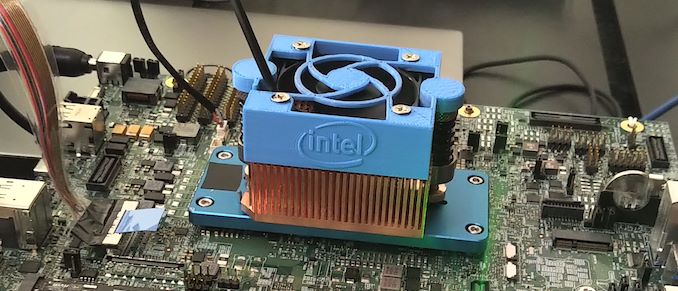
This year it seems that Intel is finally ready to talk about 10nm. After next-to-nothing on the subject at CES 2018, Intel is now talking about three new processor families: Ice Lake, Lakefield, and Snow Ridge. Despite the naming, it looks like Intel might be coming in out of the cold – to finally let it go – and roadmaps on upcoming products are being discussed.
It should be pointed out that Intel’s presentation did not mention anything about the company’s search for a new CEO, or any updates about Intel’s increased demand for its high-end Xeon processors. These are matters that the company will no doubt want to save for their earnings release later this month.
Stage 1: Consumer
Intel Client Group SVP Gregory Bryant took to the stage for Intel to announce two major hardware platforms and a new initiative in mobile computing. These were Ice Lake, Lakefield, and Project Athena.
Ice Lake: First Volume 10nm
One of the topics discussed at Intel’s Architecture Day, but under embargo until this week, is Intel’s vision for its first generation of 10nm-class consumer processors. We had already been given some details about Sunny Cove, the new Core design, as well as the updated Gen11 graphics architecture, but it will be Ice Lake that puts them both together.
Ice Lake, or more specifically Ice Lake-U it would appear, will be Intel’s first volume client processor on 10nm. Mobile processors are usually small, so it makes sense for Intel to use one for their first volume part in order to balance yields and costs – we’ve seen it before with 14nm, where Broadwell-U entered the market first. The base design from Intel looks to have four cores, eight threads, and 64 GPU execution units for graphics. Intel stated that they are driving the die area even more towards graphics under Gen11 in order to get more performance. This will be, according to Intel, its first standard (GT2-class) processor with 1 TFLOP of integrated graphics performance.
| Intel Ice Lake '4+2' For Notebooks | |
| Manufacturing Process | Intel 10nm |
| Cores / Threads | 4 / 8 |
| CPU Microarchitecture | Sunny Cove |
| Graphics Microarchitecture | Gen11 |
| Graphics Execution Units | GT2, 64 |
| TDP | 15W |
| Memory | LPDDR4X - yes LPDDR4X-3200 ? |
| Memory Bandwidth | 50-60 GB/s |
| Connectivity | TB3 over Type-C Wi-Fi 6 (802.11ax) with CRF |
| Image Processing Unit | 4th Gen |
Hardware wise, Intel explained that these processors would be using LPDDR4X. In a different segment of the presentation it was mentioned that the increase in integrated graphics (from a 24 EU configuration to a 64 EU configuration) required increasing memory bandwidth up to at least 50 GB/s. Intel did not disclose the specific memory frequencies supported, but with these bits of information I’d put LPDDR4X-3200 as the lower bound, as it offers 51.2 GB/s of bandwidth in dual channel mode. This is surprising, given that Intel is usually conservative with supported memory speed declarations – they still make a DDR4-2933 processor in their lineup – so jumping to 3200 would indeed be an unexpected shift for the company.
On the connectivity side, the chipsets for Ice Lake will enable Wi-Fi 6 (802.11ax) over the CNVi interface when an appropriate Intel CRF module is installed. Native Thunderbolt 3 is also expected, which of course operates over USB Type-C connections. Intel reworked the interface for camera support as well, adjusting the interface such that a MIPI-to-USB chip is no longer needed in a laptop bezel for webcam support.
Intel also mentioned software support, such as the new VNNI instructions, openVINO toolkit support, Cryptographic ISA instructions, and support for Overworld. These processors will have at least a similar security level as Cascade Lake, with hardware-enabled Spectre v2 mitigations.
Intel's Image Processing Unit, or IPU, is also upgraded to a fourth generation model. This part of the chip, according to Intel, now has a concurrent imaging pipeline for machine learning, and can support a single IR/RGB camera for login (e.g. Windows Hello). The IPU's power plane has also been tweaked, giving it more performance/power states so the system can save power as needed.
Ice Lake Designs: More Battery Life
Beyond the 10nm process node change, Intel also announced two additional ways in which it was improving battery life for Ice Lake-U systems. Firstly, the company described its efforts on platform innovation, saying they did a top-to-bottom analysis of what in the system is drawing power and finding ways to reduce it while still keeping performance. As a result, combined with the new ‘1W’ display technologies the company introduced at Computex in June, we’ve been told that optimized Intel devices should now be able to achieve 25+ hours of battery life.
Following a similar line of reasoning, Intel also reworked the board design specifications for thin and light devices. For a typical 12-inch laptop, Intel has freed up room for about 10% more battery capacity – going from 52 Wh to 58 Wh – thanks to reducing the total z-height and x/y dimensions of the motherboard. Interestingly, they've accomplished this without reducing the component count, bringing down the board size while retaining a given number of components.
Lakefield: Foveros Technology Coming Soon
At Intel’s Architecture Day in December, we saw a new class of chip from the company: a hybrid x86 CPU. It was a big announcement for two reasons: the first was that it featured both Core architecture and Atom architecture CPU cores, something that Intel had never done before. Ever since Arm's success with the similar concept of big.Little designs, we have been expecting Intel to come out with some products following this idea, but it was big news that this was finally the time. The second reason for it being a big announcement is that it used ‘Foveros’, Intel’s 3D active interposer technology that puts the cores and graphics on a chip on an interposer. However in a wrinkle from other interposer-based solutions, Foveros but puts the IO in the interposer (rather than using the interposer as a 'dumb' piece of silicon to route signals) all with through-silicon vias to make it work. A chip like this is much smaller in the x/y dimensions, as well as showcasing some very nice packaging technology.
Intel is giving that chip an official family name: Lakefield. The goal of designing Lakefield came from an OEM request to develop a chip that had 2 mW idle power draw, something much lower than current designs. Thus Lakefield was created. It uses a single Sunny Cove core, four Tremont Atom cores, and Gen11 graphics, all built on 10nm.
There have been questions about where exactly this chip will end up, or who even asked for it in the first place. Intel has stated that while a single customer put in the request, Lakefield will be available to all OEM partners if they want to design products around it. A lot of discussion has been held that this was an Apple request, and given Apple’s device portfolio, its volume of sales, and its desire to drive down power with optimized unique designs, the argument for Apple holds some water. But it doesn't sit right with me. This is more a low-powered chip, perhaps even lower power than the A12X in the iPads, so I don’t think Apple would want that chip in one of its MacBooks. (When we asked at architecture day, they said the chip could easily compete at the 7W TDP range, but I imagine it could go lower if needed.) Personally I’m of the opinion that it’s for the dual-screen Lenovo Yogabook. That device is super thin, super light, powers an LCD display and an eInk-like display, and doesn’t need that much power to do what it needs to do. But because it’s so thin there's limited room for battery cells, meaning that power consumption and the resulting battery life are all important, which is where Lakefield is likely to excel.
Intel announced that Lakefield was expected to be in production for products in 2019, which aligns with Intel’s commitment to having 10nm devices on shelves for the holiday season in 2019 (which would mean Christmas 2019).
Project Athena: Building Devices Ready for AI and 5G
As the single biggest force behind the PC ecosystem – and yet not a company that's selling hardware directly to consumers in most cases – Intel enjoys creating programs that try and push the market in certain directions. Depending on who you talk to, the Ultrabook program was either a big failure or a big success, but in the end it did give OEMs a chance to play with thin and light designs for a few years before the hardware gave users a good user experience and battery life. Project Athena is something slightly different, in that it will be a program for Intel and OEMs to work together to enable new experiences with technology coming in the next decade.
Terms like ‘5G’ and ‘Artificial Intelligence’ are only going to become more ubiquitous through 2020 and beyond, so Intel is jumping on it today. Current connectivity experiences for notebooks and laptops vary significantly, and AI implementations are either basic or removed from the local machine entirely and processed in cloud servers. With Project Athena, Intel is going to discuss with OEMs, with partners, customers, software developers, etc. what they need in order to enable these new terms to provide a good user experience. It isn’t just limited to 5G and AI, but we might see more requests for better AI toolkits, or power optimized designs for mobile connectivity, or more compute-related acceleration. It also extends to OEMs in their device design – if an OEM needs several cameras, or new biometrics, or supports more gestures, or new microphone array capabilities etc.
As this is a new program based in aspirational discussion followed by execution, it is unclear what the end goal will look like, only that the aim is around improvements to user experiences.
New 9th Gen Core CPUs
Intel also announced, briefly, that they will be releasing six new desktop 9th Gen Core processors, from Core i3 to Core i9. It did not disclose which parts or what the specifciations are, however we assume they will be available soon. We found the parts listed on Intel's ARK database just after the keynote and you can read our writeup here.
Also in the 9th Gen space, Intel said that the mobile 9th Gen Core processors will be available in Q2.


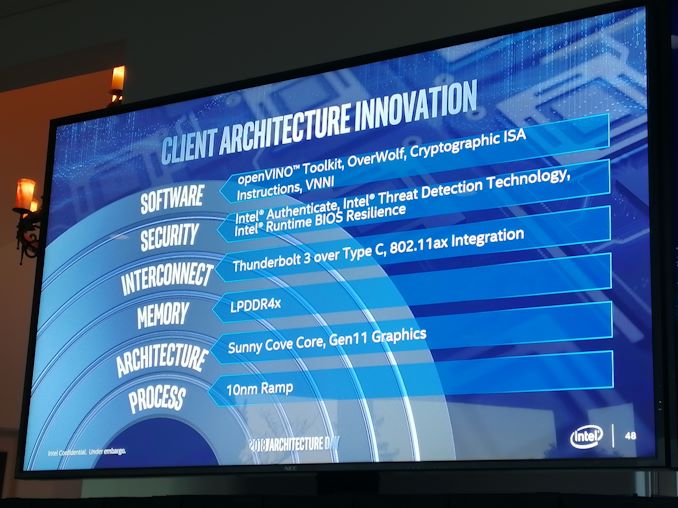
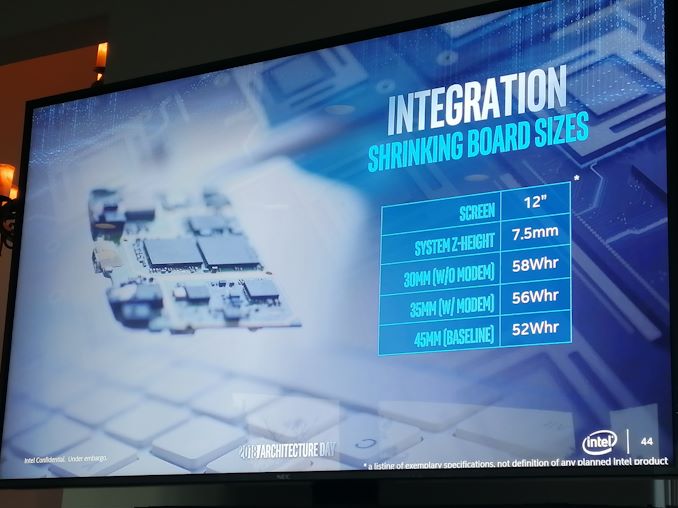
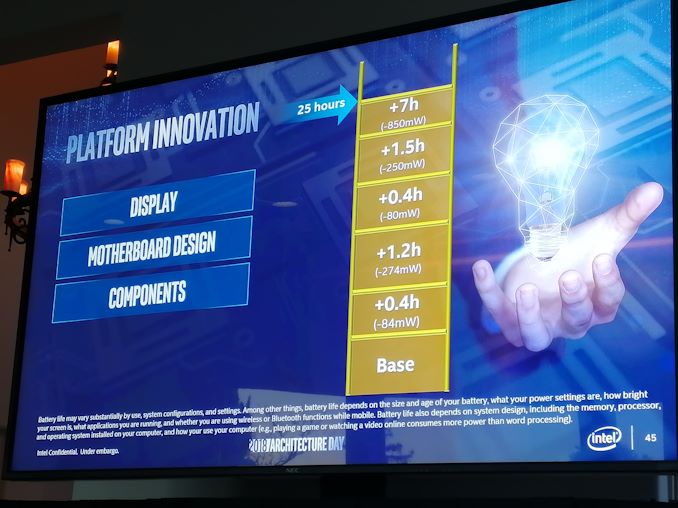
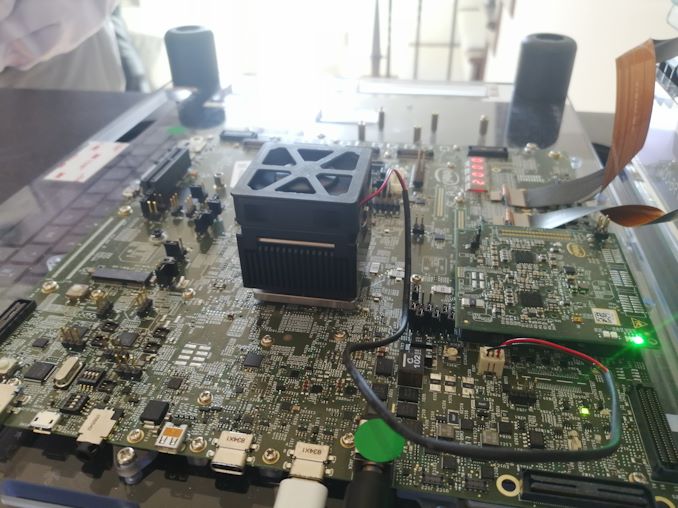
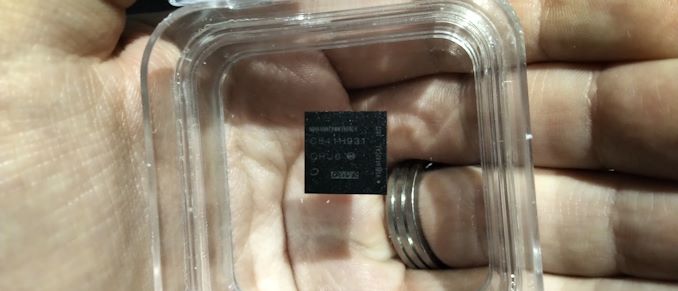








60 Comments
View All Comments
HStewart - Tuesday, January 8, 2019 - link
One more - I predict in 2020 (maybe even in late 2019) AMD will be seriously going back to drawing boardsTheJian - Tuesday, January 8, 2019 - link
Who here believes everything revolves around desktops? I want one soon on 7nm, but I think servers/hedt are what matters, along with jacked up laptops (well, ok, everything above $300 matters…ROFL, where 80% of the NET INCOME comes from that is). HIGH margin is what I've been telling AMD to chase for ages. I never said wccftech was reliable...In fact I've said the opposite, but that doesn't mean they get everything wrong. However my 1st sentence after the quote is I think their article is BS...Did you read the post or get hung up on a few caps? LOL. I said the same thing about wccftech article on AMD pricing in the Navi post (I quoted them in 2060 or AMD CES news, then called the article quoted BS). Even they don't believe their own rumors on that one...LOL. Not sure what caps have to do with reliability. GET over it.Is Intel 10nm out in volume? NOPE, why would I compare something that won't even arrive until xmas vs. 7nm AMD coming before it? As I stated, I don't believe they can make anything else but a small chip on 10nm due to LOW volume they use. NO different than AMD/NVDA doing the same with mobile etc gpu first then reticle limit (for NV anyway) after. YIELDS matter. Anandtech all but says it here too. Yay, we agree on something anandtech ;)
I know the tech matters, which is why Intel stumbled at 10nm. They shot too high (like HBM vs. GDDR5x, hard and new tools vs. simple with same tools), and failed for 2yrs now, 3 if xmas. So they shot low with 7nm to speed the process up and avoid bumps in the road. If AMD has 7nm or shortly, EVERY review will be vs. Intel 14nm chips until xmas, and even then as noted (including anandtech noting it), it's a low volume part and puny, meaning easy to produce even on a crap bad process with defect city. Also, 7nm TSMC vs. Intel 14 IS better, even if TSMC process is not as good per gen. Intel's 10nm will merely bring things to an even playing field vs. TSMC 7nm. Intel will be possibly slightly better (not looking that way now), but it won't be squashing AMD or TSMC any time soon. That will take over a year (likely 18mo+), and even then 5nm will be here for TSMC, so Intel 7nm (like TSMC 7nm as they took the easy way out, unlike usually aggressive due to 10nm failure) won't win any races really. They admitted they cut corners to speed it up. TSMC is actually making Intel chips due to 14nm shortages due to 10nm being screwed so long. You don't see the humor in this point? ;) But yeah, nm, density, gates, etc all mean a lot. But I get the tech, so point wasted on me, unless you have something that says Intel 10nm is great...WTH are you talking about?
No desktops will never be replaced for power users. I guess you haven't been around for the last 30+ years of this crap, as it is all ~80-120w on desktops, and usually ~85-95w. Let me know when your laptop can take that heat/watts. What cpu on top is using less power on desktops or servers? I see them all aimed at ~85w-120w pretty much at launch for every gen.
I said AMD only had 12-18 months in my post to make hay while the sun shines, IE, before Intel comes back if they can. But TSMC is on a roll lately, w/tapeouts, risk production etc, 5nm on track, 7nm out the door massively for apple etc. If Intel 7nm hits and tsmc 5nm very close time wise, the bleeding won't stop for Intel for a while past 12-18mo. In an even race in fabs (I'm admitting it takes a smaller process here for TSMC to match/beat Intel process in any case), the cheaper chip will win, and AMD always starts price wars (stupidly IMHO) at launches when they should be charging as much as they can get at launch until SOMEONE else starts that war (INTC/NVDA I mean). You seem confused about what I actually posted. I was very clear however with dates, launches, net income, pricing mistakes by AMD, R&D money, die sizes, what I’m planning on buying etc. How much data do I have to give to make the point clear? I feel like I’m repeating myself at this point when people should just READ the post (again? If you didn't get it) ;) You asked me to consider stuff, I already covered, albeit without mass granular detail that would bore most to death anyway :) What about my first post said to you that I'm ignorant here? If nothing is HVM basically until 2020 (xmas puny chips don't count IMHO, as it's a low volume product chosen), I'm right.
I'm not confusing the discrete gpu coming (supposedly) 2020 and don't think that will be worth much anyway. Hardware is not enough, and I've seen multiple failures in gpu stuff from Intel over the years (I sold i740 for a while). You need great drivers all year too (game ready for big AAA launches etc), and this I think will be lacking for Intel based on MUCH previous experience with their crap. They can't even take down plucky little AMD apu's and they've had YEARS to get that done. Always losing to a company with 1B R&D...LOL, never mind NV R&D and wads of cash in the bank to fight on gpu fronts.
HStewart - Tuesday, January 8, 2019 - link
You are the one that stated if 10nm is not in desktops, wasting time. To be honest - your comment seems like if it is Intel then you wasting time - so be a kind person and leave you comments to AMD articles. Just for information, I notice in other articles that AMD 7nm will not be ready in 2nd half of 2019.nm size is not everything, 10nm is only small part of Intel change coming in 2nd half of 2019 - likely 4th quarter - holiday season does not mean Dec 25th, it means before that like Fall 2019.
But with Ice Lake - it not just the stupid process - but architxture which is more signficant than the process - adding more cache and excution units.
By this article, Intel is not going low productions - not only notebooks and surely desktop - because that is where AMD fans like to fight - but also in servers and low end and next year will attack in GPU - likely ready for CES 2020. Intel is preparing to do not a Tick or a Tock - but this time they are combining Tick and Tock - mean both Process and Architexture change in a single releases.
For me, my XPS 15 2in1 will last me to late 2019 or 2020, we are going to see signifcant change in performance with this new breed. To me Sunny Cove looks like Intel's most signficant Architexture change possible even surpassing the original i series from old Pentium 4 and Core 2 days
More information on Sunny Cove can be found in this article
https://www.anandtech.com/show/13699/intel-archite...
TheJian - Wednesday, January 9, 2019 - link
https://www.anandtech.com/show/13832/amd-radeon-vi...NEW INFO First and foremost, 7nm announced today on stage, but GPU (331mm) Radeon VII. So TSMC working, we’ll see about cpu, but they can clearly do a cpu too as this GPU is 331mm^2 and that would be a fairly LARGE cpu die from AMD. But this does mean 7nm DESKTOP cpu WELL before XMAS, stating Q2/Q3 (back to school). MATISSE (mid2019 stated). The GPU is here early I guess since they just re-used MI60 chips for quick release (yield good, or left over?)
https://www.anandtech.com/show/13829/amd-ryzen-3rd...
So, adding this info above as I’ve been reading on/off all day (CES crap). So again, AMD 7nm CPU READY Mid2019.
We are talking HVM, which I called BS until a HVM product is out the door, such as a desktop for instance as noted. Or heck, "insert any HVM larger die product" you want which would mean HVM is a go! Intel has claimed (apparently) that they have ANY HVM product capability, which again, I see NONE and a SMALL product in pretty low volume doesn't scream "success, we've done it for ALL chips, even the larger ones"...Uh, no, or start producing some!
I said what I WANTED in a desktop from Intel (10nm! which again is high volume) or stated I'd buy AMD and if you're waiting on Intel, might as well take AMD 12core etc right (12/16 core will require 7nm to be effective from tsmc surely)? I gave an argument based on perf/process of the alternative, which to me seems very reasonable (it’s the only other choice in town). We see how far Intel is getting with 14nm (8 core finally mainstream? Not really at $478!), and 10nm MAY enable Intel to do a decent 12 core, but we’ll see vs. 7nm AMD from TSMC with it seems, up to 16 core on mainstream boards (room on ryzen2 (3rd gen) for another 8core chiplet) and If AMD IPC claims are true, a decent upgrade from the current story playing out. Assumed leaks say 12/16 core just moved down from HEDT to mainstream boards with AMD at some point. It will be fun to see Intel 10nm response (cancel a chipset at release again? LOL, my 6 core+Board was dead the day I bought it), just like it was fun watching pathetic 9900k/9700k etc. They had to turn HT off just to cherry pick enough for 8core/16 thread model IMHO. IE, even though they turned off ½ the threads, cache, etc, 9700k uses the same watts? How bad are your yields if you have to drop ½ threads & slow it down to hit 95w still (anandtech discussed this issue of yields and LVM too)? Is it the same core too, so you disabled 4MB of cache maybe to get yields up? No reason to leave it out as 9700k, slower, ½ threads is no competition for the chip above it and again, 95w with all this downgrading? Smells like yield issues even here at 14nm, never mind you moved production to SERVER, because you can’t keep up with demand already (thus hiring TSMC for some 14nm help…Not good either).
https://www.cnbc.com/2018/04/26/intel-execs-on-10n...
Intel execs have now admitted they “bit off a little too much” on 10nm.
https://www.extremetech.com/computing/268407-intel...
“But regardless, we’re now talking about whether Intel can match its competitors on feature sizes, not whether it’ll continue to lead the industry.” Says it all doesn’t it? My point exactly. They are not “ahead” any more. Ziff Davis here.
Pentium 4 is a great chip now, and you were excited by it?
https://www.anandtech.com/show/1611/6
Crash landing, failure says Anandtech 2005 (many others they wrote too, like everyone).
https://www.pcper.com/news/Editorial/Yes-Netburst-...
Netburst arch, REALLY was that BAD…I could go on, as every review site said this at some point. You imply this is a tech that was some kind of amazing achievement. I disagree, as does the whole web. “ridiculously huge pipeline”. You’ve never heard of PRESSHOT? Cooking with Intel? ROFL.
Intel has been promising 10nm for over 2yrs (late 2016, as noted in above article from extremetech) and now seems 3yrs late if xmas 2019 for even a SMALL chip, not really HVM as Anandtech even noted. Now you think they'll get a HVM gpu out the door for CES in Jan 2020? You’re aware they’ll be 3yrs late with 10nm at xmas right (I said it before and here again)? They failed with i740, they failed with larrabee, drivers have NEVER been good on Intel (I know I sold i740 as a PC biz I had for a decade) discrete or integrated, etc. What in Intel's history says "this time it will work" and the design time is super-fast here? I think H2 at best for discrete from Intel gpu dept based on no cpu in 2019 for HVM lager dies.
https://en.wikipedia.org/wiki/List_of_defunct_grap...
List of companies that have attempted to take on NV/AMD (er, ATI?) and failed, which BTW have mostly been gobbled up by AMD/NV. Please can you provide a link to info that says Intel will get it right where EVERYONE has failed before for 20yrs no matter the size of their budget, including INTEL? What has change THIS time?
https://www.tomshardware.com/news/intel-xe-gpu-spe...
Clearly states Intel discrete gpu will be 10nm (Intel said it), and 2020 while I don’t think they meant Jan. OK, so you think Jan 2020 CES for a LARGE chip that will compete with AMD/NV cards at, spitballing here, 300mm^2+? It will be competing with faster chips than current 12nm 445mm^2 dies @10.8B transistors (never mind ridiculous reticle limit 2080ti chips, titans etc). Both NV/AMD will have gpus at 7nm, so you have to perform even faster than these right? Intel can’t put out a 200mm^2 die at 10nm and think it will catch much larger dies on TSMC 7nm. It would appear NV will wait on 7nm until 2020 (no competition in high end this whole year, AMD going low die size THIS year), but that is to put out another reticle limit top end chip again like 2080ti and raising prices after a cut surely when AMD hits 7nm. I mean, 754mm^2 is really pushing limits on yields here, 18.6B transistors and that would even be BIG at 7nm if you just shrunk this (~400-500mm^2?).
https://insidehpc.com/2018/12/7nm-gpu-fastest-rade...
AMD 7nm MI60 gpu is 331m @13.2B, so major reduction from NV 18.6B, so again guessing Intel will be competing with NV ~450mm^2 or so (mid of my guess? Though NV probably does better than AMD here, so ~400? Whatever it’s big) if they go 18.6B or more based on AMD 331 7nm from the same process and I’ll be shocked if NV’s 3080ti (guessed name, whatever) will be less than 20B transistors and I’d guess much higher. I’d be shocked if AMD doesn’t get navi 10 out by July, and may hit early Q2 as MI60 is Q1 for purchase. They said MI60 was a pipe cleaner (smaller 331 die, but on a low volume HIGH margin product in PRO stuff), signaling a LARGER die size on at least some model for desktop later in the works right (NAVI10 is small, so not the chip discussed here)? You don’t have to pipeclean for a small desktop gpu chip, you do it for a LARGE model coming soon. AMD/Intel/NV routinely put out smaller laptops first, pipecleaning for future larger models on new processes. You are living in a fantasy world if Intel is putting out the first “supposedly” HVM 10nm small chips for xmas devices not back to school, which MIGHT make your point valid. It’s XMAS, so AFTER sept or you’d say back to school, and gpu has been said to be H2 2020. Intel isn’t dumb going after poor, there is no money in it, ask AMD (Navi10…LOL, puny). Intel will attempt to chase NV high end for margins, which means BIG, and that isn’t coming in Jan as a pipecleaner is not what is coming for xmas from Intel. It will likely be under 150mm^2, not 331 like AMD pipecleaner.
https://en.wikipedia.org/wiki/Cannon_Lake_(microar...
Cannon lake, shown running CES2017, but delayed to 2018, then CES 2018, shipping would ramp 2018, ooops, April 2018, shipping LOW VOL 10nm & cannon would be delayed AGAIN to LATE Q2 2019. It’s in a nuc now, but we’re talking a 70mm^2 dual core chip here and NUC’s don’t sell volume anyway. How many people do you know that own HTPC’s? These are less than that and expensive for a puny weak dual core (~$540). As noted they’ve been fighting yields and costs due to them sucking. They only produced ONE model AFAIK.
https://fuse.wikichip.org/news/1371/a-look-at-inte...
Architecture is important but no more so than shrinks and process upgrades (Intel 14, 14+, 14++ etc) as these allow massive watt drops, transistors, and shrinking die sizes to make more money. IE, from 4th to 5th gen on Intel, you got 35% more transistors and a 37% smaller die size (131 down to 82mm^2, and .96B to 1.3B transistors). Not sure how you can just discount this side of the equation and act like it’s just a “stupid process”…LOL. OK. You trolling me? Processes are stupid? C’mon man. Discrete gpu 2020 in January? Are you an Intel shareholder (I have been, not now) with wishful thinking or what? If Intel won’t even put out a “tentative” release date, it’s not JAN 2020. Why would you say something as non-specific as 2020, if you meant Jan, or at worst Q1? Heck they could have said H1 2020. You say 2020 when you have no idea yet as of CES 2019 speeches. NO date, just 2020. I’m sure they’re praying for Jan, but not unless they’re chasing poor people like AMD, and that is NOT Intel’s style. Also note, Intel was supposed to be on 10+ by now and 10++ this year.
https://www.anandtech.com/show/11722/intel-reveals...
https://fuse.wikichip.org/news/1910/intel-looks-to...
“A big part of keeping up the improvements to the system architecture remains the process technology.” AGREE, and the 10nm “stupid process” has held up the entire company product line right? But who needs this process crap…LOL.
“Process technology details are almost always kept secret until released due to competitive reasons.” Well, if it is just “stupid process” junk, why the heck do you think Intel guards it so closely until RELEASE? GF process has literally killed a product or two. But no, not very important even though they can literally CRUSH your product launch. Just ask Intel. They are getting less out of process today than 10yrs ago, but it’s still worth a lot. We’re done here, as I’m realizing responding to your comment is kind of a joke at this point (perhaps on me for doing it…LOL), but for anyone buying these stocks, it’s relevant info anyway and I have to do the homework like it or not (or lose money) ;)
lashek37 - Tuesday, January 8, 2019 - link
I’m more confused than than a homeless man on house arrest. your but must really hurt.croc - Tuesday, January 8, 2019 - link
What does "thejian" mean in Russian? I see one of the Russian Trump 'supporters', I call someone...HStewart - Tuesday, January 8, 2019 - link
Even though, I disagree with "theJian" technical, I would leave any type of politics out of technical discussions.ASAPscotty - Wednesday, April 3, 2019 - link
Blame everyone else for your problems, write a ton of shit no one cares about or will read, and then blame everyone for that too. You definitely aren't mentally unstable.TheJian - Monday, January 7, 2019 - link
https://www.techradar.com/news/intel-announces-its..."Intel also demonstrated how users will be able to play with its amped-up Gen II integrated graphics. Unfortunately, Intel didn't disclose any setting that they were playing the game at."
Anandtech calls no roadmaps open? NO settings open? Did they say anything of SUBSTANCE today? I've been reading Intel crap for an hour and still don't see any data from CES 2019. I see 2018 repeat.
Jorgp2 - Monday, January 7, 2019 - link
Dude, we know the EU counts.So we know around where it will perform.